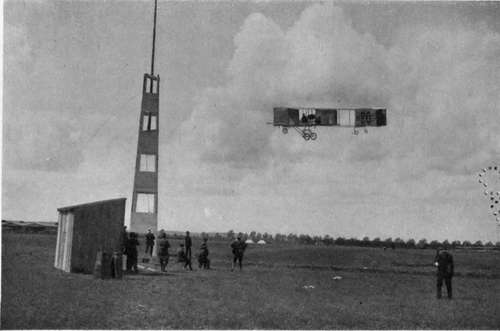The Farman Biplane
Description
This section is from the book "The New Art Of Flying", by Waldemar Kaempffert. Also available from Amazon: The New Art of Flying.
The Farman Biplane
The Farman biplane is the outcome of Henry Farman's experience with the old, cellular Voisin biplanes (Fig. 34). Like Curtiss, he was manifestly influenced by the Wrights, as, indeed, was every French maker of flying-machines after the memorable flights of Wilbur Wright in France in 1908. As it now stands, the Farman is probably the most widely used biplane in Europe and deservedly so by reason of its ingenious and extraordinarily staunch construction.
The main supporting surfaces of the Farman biplane are made of what is known as " Continental " cloth, a special fabric manufactured for aeronautic purposes. The cloth is stretched over ribs of ash. Although the dimensions vary somewhat, the average Farman biplane has a spread of 33 feet, a depth of 6.6 feet, and a total area of 430 square feet. In the later machine the upper plane has a greater spread than the lower. The planes are separated by a distance of 7 feet.
The elevation or horizontal rudder is carried out in front of the machine, after the early Wright fashion. Wires run from the rudder to a lever held by the pilot's right hand (Fig. 28). By pushing the lever away from him, the pilot depresses the rudder; by pulling the lever toward him, he tilts the rudder up.

Fig. 34. Voisin machine of 1909. Machines such as this are no longer made.
Photograph by Edwin Levick.
The same lever controls the lateral balance of the machine. Four hinged flaps, constituting the rear corners of the main planes, are connected by cables with the lever. By throwing the lever from side to side the flaps (ailerons) on one side are pulled down, and the flaps on the other side are relaxed so that they lie practically flush with the main planes. When the machine is standing still on the ground, the flaps hang down. As soon as the machine is in flight, they stream out behind the main planes.
The vertical rudder consists of two parallel vertical surfaces in the rear of the machine, which surfaces are connected by means of tiller cables with a lever worked by the pilot's feet.
Somewhat in advance of the vertical rudder are two horizontal surfaces which constitute a steadying tail. The top surface of this tail can be swung up and down in conjunction with the front horizontal rudder.
The motors used on the Farman machine are usually Gnome rotary motors of 50 horsepower, although 100 horse-power motors have been used on occasion. The propeller is a Chauvière wooden propeller of two blades, with a speed of 1,200 revolutions a minute. The pitch of the propeller is 4.62 feet, the diameter 8.5 feet.
The machine is mounted on two skids, each of which is fitted with a pair of wheels. Heavy elastic bands connect the skids with the axles of the two wheels. In alighting the bands yield and allow the skids to take the main shock.
This is a most ingenious, efficient, and simple invention, which has been widely copied.
Continue to:
